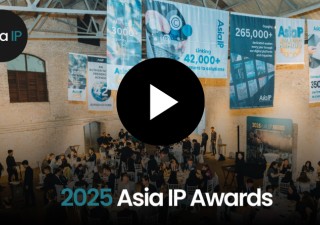Hong Kong IP Dispute Resolution Called “Efficient, Expert-driven, Equitable”
13 November 2018

As IP owners and practitioners prepare for changes to the patent and trademark protection is sought in Hong Kong, local barrister Benny Lo gave Asia IP’s Michelle Ko an insider’s look at the changes.
Asia IP: What in your opinion are some of the most important legal and business developments in Hong Kong and the region that impact IP owners and IP practitioners operating in Hong Kong?
Dr. Benny Lo: It has been a wonderfully busy time for government officials, legislators, regulators and professionals working in the IP scene in Hong Kong. The city is the lucky host to exciting recent developments that would impact upon the way IP owners and practitioners operate locally and internationally, both in the short term and long term.
Original Grant Patents and the Madrid Protocol
Beginning with IP protection, investors are preparing soup to nuts for imminent changes of significance in the way patent and trademark protection may be sought in Hong Kong.
The passing of the Patents (Amendment) Ordinance in June 2016 means that inventors will soon have the additional option of directly filing for a standard patent by original grant (OGP) without first obtaining a patent from Mainland China, the UK or the EPO (designating UK) under Hong Kong’s existing “reregistration” system.
Substantive examination of OGP applications will be conducted, and substantive examination of a short-term patent may also be requested post-grant. The new law also envisages future regulation of the provision of patent agency or patent attorney services in Hong Kong. In the interim, unlawful use of titles that imply a legal or government-endorsed qualification granted for approving the provision of patent agency services in Hong Kong will be made a criminal offence punishable by a fine.
With the roll-out of the OGP system still in its final stages, it is probably a little early to speculate its likely uptake. But it is clear that the OGP system alongside the re-registration system would offer a favourable choice for businesses, particularly SMEs, who may wish to file for patent protection only (or to file first) in Hong Kong.
Another development still waiting to be hatched is the government’s decision in early 2017 to implement the Madrid Protocol in Hong Kong. Under the Madrid system, which is administered by the International Bureau of the World Intellectual Property Organization (WIPO), trademark applicants from one contracting state can file a single international application, paying only one set of fees, to obtain a trademark registration in other contracting state(s). This is not currently possible in Hong Kong, which operates a jurisdiction-specific trademark system managed by the Hong Kong Trade Mark Registry.
The introduction of the Madrid system would make it easier for trademark owners or their agents to manage post-registration matters concerning trademark portfolio in different contracting states through a simple procedure via WIPO and the payment of one fee. It is expected that the Madrid system will finally break out of its shell here in four to five years’ time.
Corporate Financing: Biotechnology Foresight
Moving from IP protection to corporate financing, in April 2018, the Hong Kong Stock Exchange adopted new rules that broaden Hong Kong’s existing listing regime and enable companies in emerging and innovative sectors to apply for listing. IP practitioners may be eagerly eyeing the new Chapter 18A of the Main Board Listing Rules, which permits a pre-revenue biotech company to apply for listing even if it has yet to meet any of the Main Board financial eligibility tests on profits, cash flow, revenue, etc. Suitable safeguards are in place to protect investors – by requiring the applicant to satisfy minimum financial criteria and to demonstrate, through public disclosure, details of its product portfolio, patents and other forms of IP rights granted and applied for, its experience and expertise on research and development, and risks from clinical trials and product approval.
With advancements in genetic engineering, I have no doubt that new biologics will continue to emerge as effective and refined therapeutic or diagnostic agents, engineered antibodies for targeted cancer therapy being a prime example. Indeed, Hong Kong’s status as a premier listing hub coupled with the development of China and the Greater Bay Area may well start the engines of a new biotech powerhouse. IP practitioners, alongside other professionals, are well-placed to assist up-andcoming biotech companies in steering through the listing process to obtain the needed funding, and walk the steps towards curing cancer, so to say.
Arbitration of IP Disputes
Finally, on the dispute resolution front, in January 2018, amendments to the Hong Kong Arbitration Ordinance clarified that all aspects of an IP right of any nature may be the subject of arbitration, and that an arbitration award involving an IP right dispute will not be set aside or refused enforcement simply because it relates to such a dispute. This in my view is a muchawaited development for IP holders and practitioners alike. Not only does it pin arbitration firmly on the map as a reliable and speedy option for resolving domestic and international IP disputes in Hong Kong, it so happens to be a perfect match with the government’s ongoing initiative to position, develop and promote the city as a premier IP trading and dispute resolution hub and a centre for innovation and technology in the region.
AIP: Can you share a few IP-related cases you’ve handled that you believe imparts interesting takeaways for IP owners?
BL: The tribunal’s technical expertise is an oft-cited benefit of referring disputes to arbitration instead of litigation. Another benefit is plain speed.
Not Too Late to Agree to Arbitrate
In one case in which I was counsel for the defence, a local biotech company offering non-invasive prenatal testing services sought an interim injunction from the court against my client, a competitor, alleging patent infringement. The case involved highly technical subject matter, which is relatively rare for the Hong Kong courts. Parties filed reams of factual and expert evidence on issues of prior art and inventiveness. It took the application seven months before reaching a hearing, which lasted over four days. It took another two months for the decision to be delivered.
While the parties were not in a pre-existing contractual relationship, it was still open for them to enter into a post-dispute agreement to submit the case to arbitration. With the wealth of arbitrators with IP specialist knowledge in Hong Kong, and the possibility of skipping the court’s crowded waiting list, the application could have been resolved much earlier and efficiently in arbitration. I believe this is something parties in cases of this nature should generally consider, regardless of their other differences as a dispute arises.
A Well-drafted Clause is Key
Another takeaway from my contentious IP practice is to never underestimate the importance of a well-drafted dispute resolution clause. In a trademark licensing dispute in which I acted as an arbitrator, the claimant had a straightforward and perfectly meritorious claim for payment of minimum guaranteed royalties, until a vital complication arose: the claimant, when drafting the license agreement, appended a Hong Kong arbitration clause at the end covering all kinds of disputes when, elsewhere in the contract, a multi-tiered dispute resolution clause already existed that required the same dispute to first be mediated and submitted to the exclusive jurisdiction of the London courts if it could not be resolved.
The prima facie inconsistency of the two sets of dispute resolution clauses had resulted in the claimant having to file voluminous submissions and authorities to persuade the tribunal that it did have jurisdiction. Although the issue was eventually resolved, the claimant could have saved substantial time and costs with a well drafted dispute resolution clause. Therefore, IP owners should plan ahead and think about dispute resolution clauses in licensing and other contracts, and definitely not treat them as “midnight clauses.”
AIP: Are there any key lessons arbitration can teach or inform the wider scene of IP dispute resolution and protection?
BL: Yes.
Essence of Precision in Arbitral Procedures
Firstly, the use of tailor-made procedures prevalent in arbitration should be widely adopted in other dispute resolution fora. For instance, a suitable procedure for a patent infringement action could look very different from that for a trademark infringement action. There is also no reason why the procedure in a simple claim of HK$1 million (US$127,400) should be the same as that for a complex technical dispute of over US$10 billion. To this end, leading arbitral institutions have continued to innovate and refine their rules for resolving disputes more efficiently, including the mandatory use of expedited procedures (with a time limit on the whole case from beginning to the end) and documents only procedures without a hearing. Some of these ideas could certainly be adopted, perhaps with suitable modifications, to address and improve the inefficiency that may sometimes be observed in court litigation.
Tribunals Help You Plug the Leak
The second aspect, which partly overlap with the first, relates to costs control. Being exposed to upfront costs and potential costs are well-known factors that dissuade aggrieved parties from bringing disputes to court and arbitration. The arbitral tribunal’s power to impose direct limits on recoverable legal costs in suitable cases can be very useful in keeping the proportionality of the exercise in check. Costs control can also be achieved by robust case management measures such as directing focused pleadings, limiting disclosure, limiting the length of submissions and the early narrowing of issues. These techniques, whether applied by an arbitrator or by the court, can be very powerful in not only making the costs more manageable for the parties, but also speeding up the whole process considerably.
Justice Without Borders
The third aspect relates to cross-border recognition and enforcement. Thanks to the New York Convention, the ease of enforcement of arbitral awards across all major jurisdictions is currently second to none. Despite the existence of limited reciprocal enforcement of court judgments and the possible use of summary procedures, cross-border enforcement of court judgments remains, by and large, a cumbersome process.
Inspired by the New York Convention, efforts aimed at achieving ease of enforcing other forms of dispute resolution decisions have been set in motion. In particular, the work of the Hague Convention on Private International Law has led to the conclusion of the Convention on June 30, 2005, on Choice of Court Agreement that enables the recognition and enforcement of judgments from a court designated in an exclusive choice of court agreement. To widen its application, the Hague Convention is working on a draft convention for the recognition and enforcement of court judgments generally. In its recent drafts (the latest in May 2018), specific provisions are included to address recognition and enforcement of judgment that ruled on different aspects of an IP right, including questions of infringement and validity. The United Nations Commission on International Trade Law (UNCITRAL) has also worked towards a treaty and model law on the enforcement of settlement agreements from international commercial mediation, the text of which was finalized in June 2018.
AIP: If there would be one thing you could change about the current state of IP dispute resolution, whether it’s a regulatory or legislative issue or a general practice issue, what would it be?
BL: With Hong Kong winding its gears to be a hub for innovation and technology in the region, I believe it is due time to consider setting up a specialist list in our courts, even on a pilot basis, to handle IP disputes.
In 2013, the Intellectual Property Enterprise Court (IPEC) was set up in the UK (as a reconstituted form of the Patents County Court) with the aim to handle smaller IP-related disputes and to cater to the needs of SMEs. Many procedural benefits of arbitration are featured in IPEC cases, such as a cap on damages and recoverable costs, early definition of issues and short hearings. In its first few years of operation, it was observed that the IPEC had not actually reduced the case load in the High Court. This fact serves to highlight the existence of unmet needs of SMEs which would otherwise be unable to access justice and get quick decisions. A similar list in Hong Kong would, I believe, likewise address the needs of cases not amenable to, and nicely complements, the other forms of dispute resolution.
AIP: Can you sum up your vision for IP dispute resolution in Hong Kong in three words?
BL: I can do so in three letters! 3 “E”s: Efficient, Expert-driven and Equitable.






